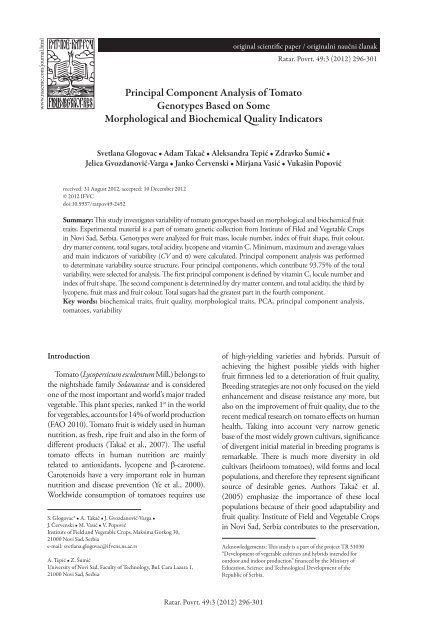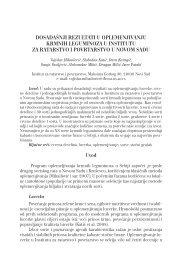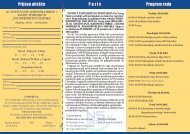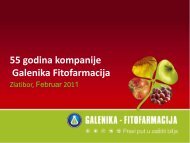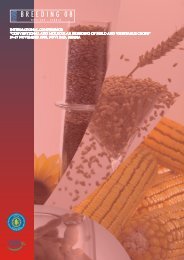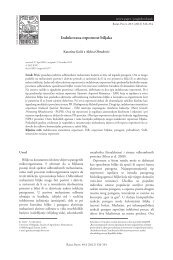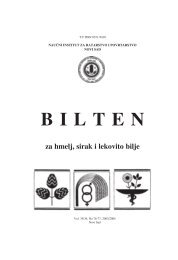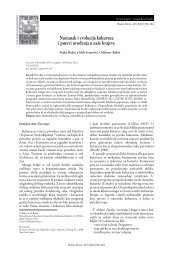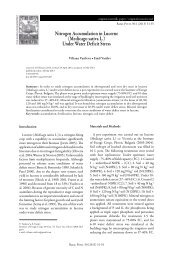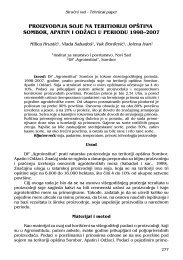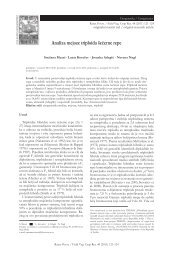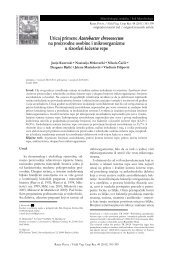Principal Component Analysis of Tomato Genotypes Based ... - CEON
Principal Component Analysis of Tomato Genotypes Based ... - CEON
Principal Component Analysis of Tomato Genotypes Based ... - CEON
You also want an ePaper? Increase the reach of your titles
YUMPU automatically turns print PDFs into web optimized ePapers that Google loves.
Glogovac S et al.<br />
original scientific paper / originalni naučni članak<br />
Ratar. Povrt. 49:3 (2012) 296-301<br />
<strong>Principal</strong> <strong>Component</strong> <strong>Analysis</strong> <strong>of</strong> <strong>Tomato</strong><br />
<strong>Genotypes</strong> <strong>Based</strong> on Some<br />
Morphological and Biochemical Quality Indicators<br />
Svetlana Glogovac • Adam Takač • Aleksandra Tepić • Zdravko Šumić •<br />
Jelica Gvozdanović-Varga • Janko Červenski • Mirjana Vasić • Vukašin Popović<br />
received: 31 August 2012, accepted: 10 December 2012<br />
© 2012 IFVC<br />
doi:10.5937/ratpov49-2452<br />
Summary: This study investigates variability <strong>of</strong> tomato genotypes based on morphological and biochemical fruit<br />
traits. Experimental material is a part <strong>of</strong> tomato genetic collection from Institute <strong>of</strong> Filed and Vegetable Crops<br />
in Novi Sad, Serbia. <strong>Genotypes</strong> were analyzed for fruit mass, locule number, index <strong>of</strong> fruit shape, fruit colour,<br />
dry matter content, total sugars, total acidity, lycopene and vitamin C. Minimum, maximum and average values<br />
and main indicators <strong>of</strong> variability (CV and σ) were calculated. <strong>Principal</strong> component analysis was performed<br />
to determinate variability source structure. Four principal components, which contribute 93.75% <strong>of</strong> the total<br />
variability, were selected for analysis. The first principal component is defined by vitamin C, locule number and<br />
index <strong>of</strong> fruit shape. The second component is determined by dry matter content, and total acidity, the third by<br />
lycopene, fruit mass and fruit colour. Total sugars had the greatest part in the fourth component.<br />
Key words: biochemical traits, fruit quality, morphological traits, PCA, principal component analysis,<br />
tomatoes, variability<br />
Introduction<br />
<strong>Tomato</strong> (Lycopersicum esculentum Mill.) belongs to<br />
the nightshade family Solanaceae and is considered<br />
one <strong>of</strong> the most important and world’s major traded<br />
vegetable. This plant species, ranked 1 st in the world<br />
for vegetables, accounts for 14% <strong>of</strong> world production<br />
(FAO 2010). <strong>Tomato</strong> fruit is widely used in human<br />
nutrition, as fresh, ripe fruit and also in the form <strong>of</strong><br />
different products (Takač et al., 2007). The useful<br />
tomato effects in human nutrition are mainly<br />
related to antioxidants, lycopene and β-carotene.<br />
Carotenoids have a very important role in human<br />
nutrition and disease prevention (Ye et al., 2000).<br />
Worldwide consumption <strong>of</strong> tomatoes requires use<br />
S. Glogovac* • A. Takač • J. Gvozdanović-Varga •<br />
J. Červenski • M. Vasić • V. Popović<br />
Institute <strong>of</strong> Field and Vegetable Crops, Maksima Gorkog 30,<br />
21000 Novi Sad, Serbia<br />
e-mail: svetlana.glogovac@ifvcns.ns.ac.rs<br />
A. Tepić • Z. Šumić<br />
University <strong>of</strong> Novi Sad, Faculty <strong>of</strong> Technology, Bul. Cara Lazara 1,<br />
21000 Novi Sad, Serbia<br />
<strong>of</strong> high-yielding varieties and hybrids. Pursuit <strong>of</strong><br />
achieving the highest possible yields with higher<br />
fruit firmness led to a deterioration <strong>of</strong> fruit quality.<br />
Breeding strategies are not only focused on the yield<br />
enhancement and disease resistance any more, but<br />
also on the improvement <strong>of</strong> fruit quality, due to the<br />
recent medical research on tomato effects on human<br />
health. Taking into account very narrow genetic<br />
base <strong>of</strong> the most widely grown cultivars, significance<br />
<strong>of</strong> divergent initial material in breeding programs is<br />
remarkable. There is much more diversity in old<br />
cultivars (heirloom tomatoes), wild forms and local<br />
populations, and therefore they represent significant<br />
source <strong>of</strong> desirable genes. Authors Takač et al.<br />
(2005) emphasize the importance <strong>of</strong> these local<br />
populations because <strong>of</strong> their good adaptability and<br />
fruit quality. Institute <strong>of</strong> Field and Vegetable Crops<br />
in Novi Sad, Serbia contributes to the preservation,<br />
Acknowledgements: This study is a part <strong>of</strong> the project TR 31030<br />
“Development <strong>of</strong> vegetable cultivars and hybrids intended for<br />
outdoor and indoor production” financed by the Ministry <strong>of</strong><br />
Education, Science and Technological Development <strong>of</strong> the<br />
Republic <strong>of</strong> Serbia.<br />
Ratar. Povrt. 49:3 (2012) 296-301
<strong>Tomato</strong> <strong>Genotypes</strong> PCA <strong>Based</strong> on Quality Indicators 297<br />
examination and maintenance <strong>of</strong> tomato collection.<br />
The objective <strong>of</strong> this paper was to study genetic<br />
diversity <strong>of</strong> a part <strong>of</strong> that collection in terms <strong>of</strong><br />
some fruit quality parameters.<br />
Materials and Methods<br />
The experimental material comprised <strong>of</strong> ten tomato<br />
genotypes which included four local populations<br />
(Bitoljski kasni, Bitoljski rani, Đevđelijski, Tetovski)<br />
and six old cultivars (Novosadski rani, Novosadski<br />
export, Golden jubilei, Saint Pierre, Rutgers,<br />
Novosadski jabučar). The field trail was arranged<br />
in a randomized complete block design with three<br />
replications, two rows in each, at Rimski šančevi site<br />
(near Novi Sad, Serbia) during the season <strong>of</strong> 2008.<br />
Space between rows was 1.4 m and between plants<br />
in a row 0.5 m. The observations were recorded<br />
on the following fruit traits: fruit mass, dry matter<br />
content (total solids), total sugars, total acidity,<br />
lycopene, vitamin C, locule number, index <strong>of</strong> fruit<br />
shape and fruit colour.<br />
Total solids were determined by drying the<br />
samples at 105°C until constant mass was obtained.<br />
Titratable acidity was determined volumetrically<br />
by titration with NaOH standard solution. Sugar<br />
content was determined by the method <strong>of</strong> Luff-<br />
Schoorl. This chemical analysis was performed in<br />
Ratar. Povrt. 49:3 (2012) 296-301<br />
accordance with established national regulations<br />
(Pravilnik o metodama uzimanja uzoraka i vršenja<br />
hemijskih i fizičkih analiza radi kontrole kvaliteta<br />
proizvoda od voća i povrća, 1983). Vitamin C<br />
content was measured by HPLC analysis at the<br />
HPLC system (Agilent 1100, USA) equipped<br />
with C-8 column and DAD detector. Lycopene<br />
content was determined spectrophotometrically<br />
(Vračar, 2001), after separation by column<br />
chromatography. Stationary phase was the mixture<br />
<strong>of</strong> Al 2<br />
O 3<br />
and MgO (1:1), previously activated<br />
at 400°C. The mobile phase was the mixture <strong>of</strong><br />
hexane:methanol (9:1).<br />
<strong>Principal</strong> component analysis was used to<br />
determine the source and structure <strong>of</strong> variation as<br />
well as contribution <strong>of</strong> the observed characteristics in<br />
total variability. As a method <strong>of</strong> multivariate analysis,<br />
it performs the transformation <strong>of</strong> the initial variables<br />
into a limited number <strong>of</strong> uncorrelated new variables.<br />
Data were processed in the statistical s<strong>of</strong>tware<br />
Statistica 9 (StatS<strong>of</strong>t Inc. Corporation, Tulsa, USA).<br />
Results and Discussion<br />
Minimum, maximum and average values were<br />
calculated for the analyzed genotypes, as well as<br />
coefficient <strong>of</strong> variation and standard deviation as<br />
main indicators <strong>of</strong> variability (Table 1).<br />
Table 1. Investigated tomato genotypes and mean values <strong>of</strong> morphological and biochemical fruit traits<br />
Tabela 1. Analizirani genotipovi paradajza i prosečne vrednosti morfoloških i biohemijskih svojstava ploda<br />
Genotype FM DM TS TA LYC VIT C LN FI FC *<br />
Bitoljski kasni 98.2 6.3 94.8 6.0 1550.9 832.2 3.9 0.8 4<br />
Bitoljski rani 49.3 5.6 53.1 6.6 796.5 937.8 2.8 0.8 4<br />
Đevđelijski 65.1 5.5 82.5 6.9 1437.1 721.5 2.0 1.0 4<br />
Tetovski 54.0 6.1 54.0 4.6 910.9 846.0 2.8 1.0 4<br />
Novosadski rani 118.1 5.4 70.2 8.6 912.1 1027.1 10.2 0.5 4<br />
Novosadski export 91.4 5.7 70.0 6.8 983.5 650.4 2.2 0.9 4<br />
Golden jubilei 170.1 6.1 72.8 8.2 320.0 793.9 4.7 0.9 2<br />
Saint Pierre 150.0 6.3 73.6 5.7 916.0 863.7 4.8 0.9 4<br />
Rutgers 200.0 6.8 60.6 5.0 1135.9 954.1 6.5 0.8 4<br />
Novosadski jabučar 125.2 6.3 51.0 6.2 1187.0 949.1 3.9 0.9 4<br />
Mean 112.1 6.0 68.2 6.5 1015.0 857.6 4.4 0.9 -<br />
Min 49.3 5.4 51.0 4.6 320.0 650.4 2.0 0.5 -<br />
Max 200.0 6.8 94.8 8.6 1550.9 1027.1 10.2 1.0 -<br />
CV % 44.97 7.6 20.44 19.49 34.01 13.42 56.19 16.87 -<br />
σ 50.42 0.46 13.95 1.26 345.22 115.05 2.46 0.14 -<br />
*<br />
Fruit color according to the UPOV descriptors: 1- yellow; 2-orange; 4-red<br />
FM-fruit mass (g); DM-dry matter (%); TS-total sugars(g/100 g dm); TA-total acidity(g/100 g dm); LYC- lycopene(mg/100 g dm); VIT<br />
C-vitamin C(mg/100 g dm); LN- locule number; FI- fruit index; FC-fruit color
298<br />
Number <strong>of</strong> components which would be<br />
retained in further analysis was defined according<br />
to relations between the eigenvalues (Figure 1).<br />
Contribution <strong>of</strong> the first four components in total<br />
variance was shown, expressed in percentage, as<br />
well as the characteristics which were crucial for<br />
components defining (Table 2).<br />
Glogovac S et al.<br />
The first component accounts for approximately<br />
32.93% <strong>of</strong> the total variance. The most important<br />
traits in the first principal component were:<br />
vitamin C, locule number and index <strong>of</strong> fruit shape.<br />
It is known that vitamin C (ascorbic acid)<br />
has an important role in biochemical processes,<br />
neurotransmission and immunity (Martinez,<br />
3,5<br />
Eigenvalues <strong>of</strong> correlation matrix<br />
Active variables only<br />
3,0<br />
32,93%<br />
Eigenvalue<br />
2,5<br />
2,0<br />
1,5<br />
1,0<br />
23,76%<br />
21,57%<br />
15,49%<br />
0,5<br />
0,0<br />
2,56% 2,12% 1,02% ,47% ,08%<br />
-0,5<br />
-1 0 1 2 3 4 5 6 7 8 9 10 11<br />
Eigenvalue number<br />
Figure 1. Percentage <strong>of</strong> variability explained by main principal components<br />
Grafik 1. Procenat varijabilnosti objašnjen glavnim komponentama<br />
Table 2. Rotated components <strong>of</strong> nine tomato traits<br />
Tabela 2. Rotirane komponete za devet ispitivanih svojstva paradajza<br />
Variable<br />
Main components<br />
PCA 1 PCA 2 PCA 3 PCA 4<br />
Dry matter 0.032192 -0.743874 0.589661 -0.274169<br />
Total sugars 0.100607 0.354708 -0.142242 -0.888827<br />
Lycopene 0.447678 -0.384416 -0.572140 -0.501460<br />
Vitamin C -0.692987 -0.532220 -0.240318 0.275819<br />
Total acidity -0.556331 0.776033 -0.132577 -0.092937<br />
Fruit mass -0.560052 -0.334688 0.589762 -0.395496<br />
Locule number -0.925281 -0.185896 -0.179431 -0.157909<br />
Fruit index 0.835553 0.031070 0.484349 0.094214<br />
Fruit colour 0.307506 -0.527287 -0.745539 0.051535<br />
Eigenvalue 2.963821 2.137996 1.941044 1.394242<br />
% Total variance 32.93135 23.75551 21.56715 15.49158<br />
Cumulative % 32.9313 56.6869 78.2540 93.7456<br />
Ratar. Povrt. 49:3 (2012) 296-301
<strong>Tomato</strong> <strong>Genotypes</strong> PCA <strong>Based</strong> on Quality Indicators 299<br />
1998). High content <strong>of</strong> vitamin C in tomato fruit<br />
determinates its high biological value. However,<br />
ascorbic acid content is highly unstable and varies<br />
greatly depending on environmental conditions.<br />
In the assessed material, vitamin C content<br />
ranged from 650.4 to 1027.1 mg/100 g dm, with<br />
CV 13.42%. The richest genotype in vitamin C<br />
was Novosadski rani, while the least content was<br />
measured in the variety Novosadski export.<br />
Locule number has an influence on the fruit<br />
shape and size. In the analyzed genotypes locule<br />
number ranged from 2.0 to 10.2 with CV<br />
56.19%. Local population Đevđelijski, with the<br />
smallest fruit (after populations Bitoljski rani<br />
and Tetovski), had the lowest locule number,<br />
while cultivar Novosadski rani, with the most<br />
flattened fruit had the highest locule number in<br />
the examined material.<br />
Fruit shape is usually calculated as fruit height<br />
and width ratio, known as “fruit shape index”<br />
(Gonzalo & Van der Knaap, 2008). Round<br />
fruits <strong>of</strong> uniform size are favourable for manual<br />
harvesting, while elongated fruits facilitate<br />
mechanical harvesting. Fruit index ranged from<br />
0.5 to 1.0 with CV 16.87%. Novosadski rani<br />
had the lowest index <strong>of</strong> fruit shape and the most<br />
flattened, ribbed fruit. Although consumers’<br />
demands are different, most <strong>of</strong> them require<br />
round tomatoes with uniform size.<br />
The second component accounts for<br />
approximately 23.76% <strong>of</strong> the total variance. This<br />
component is defined by dry matter content and<br />
total acidity.<br />
Dry matter content is a very important<br />
indicator <strong>of</strong> fruit quality, both for canning<br />
industry and fresh consumption. Dry matter<br />
<strong>of</strong> tomato fruit is comprised <strong>of</strong> water-soluble<br />
dry matter (about 88%) originating mainly<br />
from sugars, acids, proteins and water-soluble<br />
pectic substances (pectinic acid). Cellulose,<br />
hemicellulose, pectic acid and protopectin are<br />
water-insoluble components (Tepić et al., 2006).<br />
<strong>Tomato</strong>es with high dry matter content are<br />
highly desirable in processing as they significantly<br />
increase the quality <strong>of</strong> the processed product (De<br />
Pascale et al., 2001). Determined dry matter<br />
values ranged from 5.4 to 6.8% with CV 7.6%.<br />
The highest value was measured in old cultivar<br />
Rutgers, while cultivar Novosadski rani had the<br />
least dry matter content. Majority <strong>of</strong> analyzed<br />
genotypes had dry matter content above 6.0%.<br />
Acids content is very important for fruit<br />
flavour and for quality <strong>of</strong> processed tomato. The<br />
most common acids in tomato fruit are: citric,<br />
malic and oxalic. The amount <strong>of</strong> organic acids in<br />
tomato fruits depends on the variety, degree <strong>of</strong><br />
maturity and growing conditions. The lowest acids<br />
content (4.6 g/100g dm) was measured in local<br />
population Tetovski, while cultivar Novosadski<br />
rani was characterized with the highest acidity<br />
value (8.6 g/100g dm). This quality parameter<br />
had CV 19.49% in the analyzed material.<br />
The third principal component contributes<br />
21.57% <strong>of</strong> the total variance. The most important<br />
traits in this component were: lycopene, fruit<br />
mass and fruit colour.<br />
<strong>Tomato</strong> is one <strong>of</strong> the main sources <strong>of</strong> lycopene.<br />
Carotenoid lycopene is a natural antioxidant, very<br />
important in prevention <strong>of</strong> many diseases. The<br />
fact that human organism is not able to synthesize<br />
lycopene increases the importance <strong>of</strong> tomato in<br />
nutrition, and therefore in breeding programs.<br />
Varieties rich in lycopene are very important for<br />
industrial processing and for fresh consumption as<br />
well, since consumers are demanding food with high<br />
nutraceutical values. Analyzed genotypes were very<br />
divergent in lycopene content since it ranged from<br />
320.0 to 1,550.9 mg/100 g dm with CV 34.01%.<br />
The highest amount <strong>of</strong> lycopene was established<br />
in local population Bitoljski kasni, while the least<br />
amount <strong>of</strong> lycopene was measured in cultivar<br />
Golden jubilei, since it has orange fruit colour.<br />
Fruit mass depends on many factors: varieties,<br />
environmental conditions, type <strong>of</strong> growing, etc.<br />
Depending on the mass, fruits are classified into<br />
groups: large (120-250 g), medium (80-120 g),<br />
small (60-80 g) and also cocktail (30-50 g) and<br />
cherry types (10-30 g) (Đurovka et al., 2006).<br />
Fruit mass varied from 49.3 to 200.0 g with CV<br />
44.97%. Bearing in mind that this trait defines<br />
cultivar purpose, divergence <strong>of</strong> genetic material in<br />
fruit mass is very significant for breeding programs.<br />
Old cultivar Rutgers had the highest fruit mass,<br />
and also the highest dry matter content, among<br />
all analyzed genotypes. Local population Bitoljski<br />
rani had the lowest fruit mass.<br />
Colour is an important quality indicator.<br />
Depending on structures and concentrations <strong>of</strong><br />
carotenoids (lycopene, β-carotene, ζ-carotene,<br />
etc.) tomato colour may be: red, orange, yellow,<br />
purple, or even white. All analyzed genotypes had<br />
red fruits apart from one cultivar, Golden jubilei.<br />
Ratar. Povrt. 49:3 (2012) 296-301
300<br />
There is a correlation between fruit colour and<br />
total antioxidant concentration, with lycopene<br />
increasing from the rose to red colour stages.<br />
Brandt et al. (2006) emphasized the increase <strong>of</strong> red<br />
colour intensity with increase <strong>of</strong> lycopene content.<br />
The fourth main component explained 15.49%<br />
<strong>of</strong> total variability with total sugars as the most<br />
important trait. Total sugar content and acidity<br />
are <strong>of</strong> the highest importance for fruit taste<br />
(Rodica et al., 2008). Total sugars ranged between<br />
51.0 and 94.8 g/100 g dm with CV 20.44%. The<br />
highest value <strong>of</strong> total sugars was measured in<br />
cultivar Bitoljski kasni, while cultivar Novosadski<br />
jabučar had the least sugar content.<br />
Conclusions<br />
The variability <strong>of</strong> the investigated morphological<br />
and biochemical traits was determined for all<br />
genotypes included in the analysis. The highest<br />
variability was established in locule number (CV<br />
56.19%), fruit mass (CV 44.97%) and lycopene<br />
content (CV 34.01%).<br />
<strong>Genotypes</strong> with high dry matter and lycopene<br />
content and different fruit mass depending on<br />
harvesting method should be used for creation<br />
<strong>of</strong> varieties intended for industrial purposes.<br />
<strong>Genotypes</strong> with balanced sugars/acids ratio, high<br />
dry matter, lycopene and vitamin C content<br />
are desirable for creation <strong>of</strong> cultivars for fresh<br />
consumption.<br />
High content <strong>of</strong> dry matter, lycopene, total<br />
sugars and vitamin C was determined in most <strong>of</strong><br />
the genotypes. Since consumers demand highquality<br />
tomatoes with good flavour, as is the case<br />
in traditional varieties, and food that prevents<br />
different diseases, analyzed genotypes should<br />
be used in organic production and in breeding<br />
process to increase fruit quality.<br />
References<br />
Glogovac S et al.<br />
Brandt, S., Pék, Z., Barna, É., Lugasi, A., & Helyes, L.<br />
(2006). Lycopene content and colour <strong>of</strong> ripening tomatoes<br />
as affected by environmental conditions. Journal <strong>of</strong> the<br />
Science <strong>of</strong> Food and Agriculture, 86(4), 568-572. doi:<br />
10.1002/jsfa.2390<br />
De Pascale, S., Maggio, A., Fogliano, V., Ambrosino, P., &<br />
Retieni, A. (2001). Irrigation with saline water improves<br />
carotenoids content and antioxidant activity <strong>of</strong> tomato.<br />
The Journal <strong>of</strong> Horticultural Science & amp; Biotechnology,<br />
76, 447-453.<br />
Đurovka, M., Lazić, B., Bajkin, A., Potkonjak, A., Marković,<br />
V., Ilin, Ž., & Todorović, V. (2006). Proizvodnja povrća<br />
i cveća u zaštićenom prostoru. Novi Sad: Poljoprivredni<br />
fakultet.<br />
Gonzalo, M. J., & Knaap, E. (2008). A comparative analysis<br />
into the genetic bases <strong>of</strong> morphology in tomato varieties<br />
exhibiting elongated fruit shape. Theoretical and Applied<br />
Genetics, 116(5), 647-656. doi: 10.1007/s00122-007-<br />
0698-7<br />
Martínez, J. A. (1998). Fundamentos teórico-prácticos<br />
de Nutrición y dietética. España: McGraw-Hill,<br />
Interamericana.<br />
Pravilnik o metodama uzimanja uzoraka i vršenja hemijskih i<br />
fizičkih analiza radi kontrole kvaliteta proizvoda od voća i<br />
povrća. Službeni list SFRJ, (1983). 29.<br />
Rodica, S., Apahidean, S.A., Apahidean, M., Manitiu, D.,<br />
& Paulette, L. (2008). Yield, Physical and Chemical<br />
Characteristics <strong>of</strong> Greenhouse <strong>Tomato</strong> Grown on Soil<br />
and Organic Substratum. In: 43rd Croatian and 3rd<br />
International Symposium on Agriculture. Opatija, Croatia.<br />
439-443.<br />
Takač, A., Gvozdenović, Đ., Gvozdanović-Varga, J., Vasić,<br />
M., & Bugarski, D. (2005). Characteristics <strong>of</strong> old tomato<br />
cultivars. Natura Montenegrina, 4, 83-91.<br />
Takač, A., Gvozdenović, Đ., Bugarski, D., & Červenski, J.<br />
(2007). Savremena proizvodnja paradajza. Zbornik radova<br />
Instituta za ratarstvo i povrtarstvo. 43 (1), 269-281.<br />
Tepić, A. N., Vujičić, B. L., Takač, A. J., Krstić, B. Đ., &<br />
Čalić, L. J. (2006). Chemical heterogenity <strong>of</strong> tomato<br />
inbred lines. Acta periodica technologica. 37, 45-50.<br />
Vračar, L. O. (2001). Priručnik za kontrolu kvaliteta<br />
svežeg i prerađenog voća, povrća i pečurki i osvežavajućih<br />
bezalkoholnih pića. Novi Sad: Tehnološki fakultet.<br />
www.fao.org<br />
Ye, X., Al-Babili, S., Kloti, A., Zhang. J., Lucca, P., Beyer,<br />
P., & Potrykus, I. (2000). Engineering the provitamin A<br />
(beta-carotene) biosynthetic pathway into (carotenoidfree)<br />
rice endosperm. Science. 287(5451), 303-5. doi:<br />
10.1126/science.287.5451.303<br />
Ratar. Povrt. 49:3 (2012) 296-301
<strong>Tomato</strong> <strong>Genotypes</strong> PCA <strong>Based</strong> on Quality Indicators 301<br />
Metoda glavnih komponenata u analizi morfoloških i biohemijskih<br />
parametara kvaliteta paradajza<br />
Svetlana Glogovac • Adam Takač • Aleksandra Tepić • Zdravko Šumić •<br />
Jelica Gvozdanović-Varga • Janko Červenski • Mirjana Vasić • Vukašin Popović<br />
Izvod: Cilj istraživanja je bio da se ispita genetička varijabilnost genotipova paradajza na osnovu morfoloških i<br />
biohemijskih osobina ploda. Eksperimentalni materijal predstavlja deo genetske kolekcije paradajza Instituta za<br />
ratarstvo i povrtarstvo u Novom Sadu. Ispitivane su sledeće osobine ploda: masa, broj komora, indeks oblika, boja,<br />
sadržaj suve materije, ukupni šećeri, ukupna kiselost, sadržaj likopena i vitamina C. Izračunate su minimalne,<br />
maksimalne i prosečne vrednosti kao i osnovni pokazatelji varijabilnosti (CV i σ). Struktura izvora varijabilnosti<br />
utvrđena je primenom metode glavnih komponenata. Četiri glavne komponente, kojima je objašnjeno 93,75%<br />
ukupne varijabilnosti, odabrano je za dalju analizu. Najveći udeo u prvoj glavnoj komponenti imali su vitamin C,<br />
broj komora i indeks oblika ploda. Druga komponenta je objašnjena sadržajem suve materije i ukupnih kiselina, a<br />
treća sadržajem likopena, bojom i masom ploda. Ukupni šećeri imali su najveći udeo u četvrtoj glavnoj komponenti.<br />
Ključne reči: biohemijske osobine, kvalitet ploda, metoda glavnih komponenata, morfološke osobine, paradajz,<br />
PCA, varijabilnost<br />
Ratar. Povrt. 49:3 (2012) 296-301


